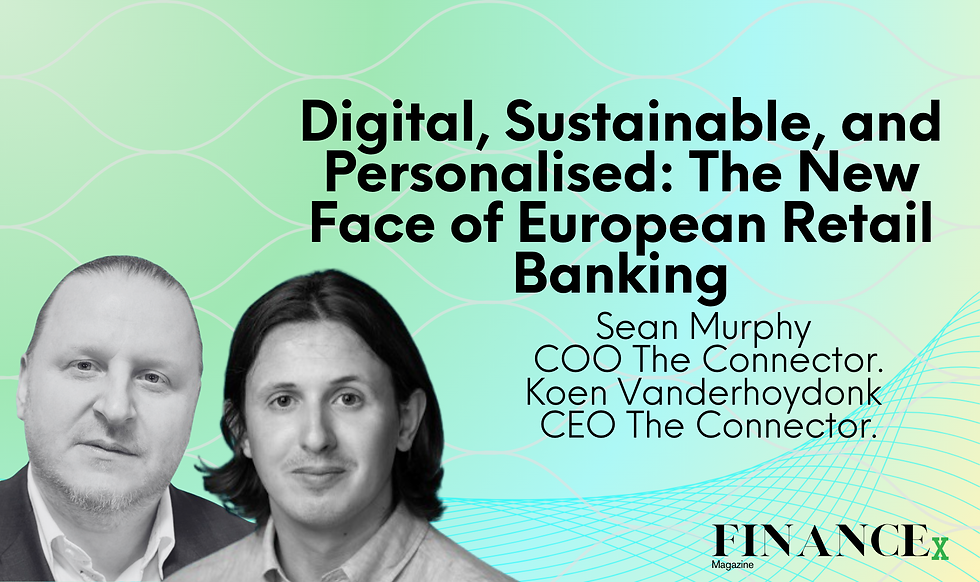Digital, Sustainable, and Personalised: The New Face of European Retail Banking
- rozemarijn.de.neve
- 11 hours ago
- 3 min read

European retail banking is experiencing profound shifts driven by digital innovation, sustainability, and the rising expectation for highly personalised customer experiences. In this rapidly evolving landscape, banks are not merely adapting; they are proactively redefining their roles, emphasising agility, customer-centricity, and ethical practices to align closely with contemporary consumer demands.
Navigating Economic Shifts and Interest Rate Challenges
European banks remain on alert as inflation cools and central banks signal gradual rate cuts through 2025. However, macroeconomic headwinds persist, including slowing growth, trade tensions, corporate vulnerabilities, and geopolitical risks like sanctions and regional conflicts.
In this environment, banks are prioritising deposit growth and strategic liability management to maintain margin resilience, even as lending slows. Digital banking tools have become essential to this strategy, facilitating more efficient account acquisition, real-time liquidity management, personalised deposit incentives, and streamlined customer journeys.
However, digital expansion also introduces new cybersecurity challenges. Regulators and institutions alike are emphasising the increasing sophistication of cyber threats, including phishing, malware, ransomware, and supply chain vulnerabilities. Banks are responding proactively by implementing multi-factor authentication, biometric logins, AI-powered threat detection, and advanced encryption protocols to safeguard customer data and sustain depositor confidence.
Tailored Services for Affluent Customers
European banks are increasingly recognising the unique demands of affluent clients, who expect bespoke financial services combined with personalised experiences. Leveraging data analytics and artificial intelligence, banks now offer tailored financial products and advisory services. These tools empower banks to understand individual customer profiles better, facilitating customised recommendations ranging from exclusive investment opportunities to tailored lending terms.
This strategic pivot toward personalisation not only deepens customer relationships but also enhances banks’ ability to retain affluent clients in a competitive market. Given the sensitive nature of affluent clients’ data, robust cybersecurity remains paramount. European banks are investing in advanced protective measures, including biometric authentication and end-to-end data encryption, to maintain confidentiality and trust.
Digital Transformation and Enhanced Customer Engagement
The digital transformation journey in European banking continues to profoundly reshape customer interactions. Banks are prioritising frictionless digital experiences, simplifying transactions, and streamlining service delivery. By harnessing the capabilities of big data, predictive analytics, and AI, banks are increasingly able to anticipate customer needs, providing proactive, timely, and highly relevant financial advice.
This enhanced digital experience, however, demands rigorous cybersecurity frameworks. Banks across Europe are thus at the forefront of adopting innovative security technologies, ensuring that the transition to digital enhances customer trust rather than undermining it.
Commitment to Sustainability and ESG Initiatives
Sustainability is no longer optional; it is central to modern European banking. Banks across the region are integrating environmental, social, and governance (ESG) principles into their core operations. Products such as green mortgages and ESG-aligned investment portfolios allow customers to align their finances with sustainability preferences.
This shift goes well beyond regulatory compliance or brand image. The European Banking Authority has recently launched a dedicated dashboard to monitor climate risks in the banking sector. Upcoming requirements under CRR3 aim to simplify and standardise ESG disclosures, demonstrating how structured sustainability is becoming. With stakeholders scrutinising banks’ claims, highlighted by recent events such as the DWS greenwashing settlement and UBS’s wavering on net-zero commitments, banks that authentically integrate ESG gain a competitive edge.
Customers expect transparency on how their money supports climate action, social good, and sound governance. Banks that embed ESG genuinely while satisfying evolving disclosure standards strengthen both trust and loyalty.
Hybrid Models Combining Digital Efficiency and Personal Interaction
Despite the rapid pace of digital adoption, European banks recognise the enduring value of human interaction, particularly for complex advisory services and significant financial decisions. Consequently, banks are embracing hybrid engagement models that blend digital convenience with the depth of personal interaction. Customers now have the flexibility to choose their preferred engagement channel, whether digital or in-person, depending on their immediate needs.
This hybrid approach not only enhances customer satisfaction but also emphasises the necessity of robust cybersecurity measures to protect customer information across all interaction channels. Ensuring data security in both digital and face-to-face interactions remains a top priority for banks aiming to build lasting customer relationships.
Looking Forward: A Dynamic Future for European Retail Banking
The future of European retail banking continues to be shaped by digital agility, personalized services, and enduring commitments to sustainability and security. Institutions that lead in these areas are setting new industry standards and transforming how customers interact with financial services.
At the same time, this evolution underscores the broader role of finance in addressing social and environmental challenges. As banks respond to shifting expectations both regulatory and societal the emphasis is moving beyond innovation for its own sake toward innovation with impact. Customer centricity remains essential, but leadership now also means contributing to a more transparent, inclusive, and sustainable financial ecosystem.
We look forward to following how these developments unfold and how banks rise to the opportunities and challenges ahead. In the meantime, we wish all our readers a restful and inspiring summer holiday season
.png)


